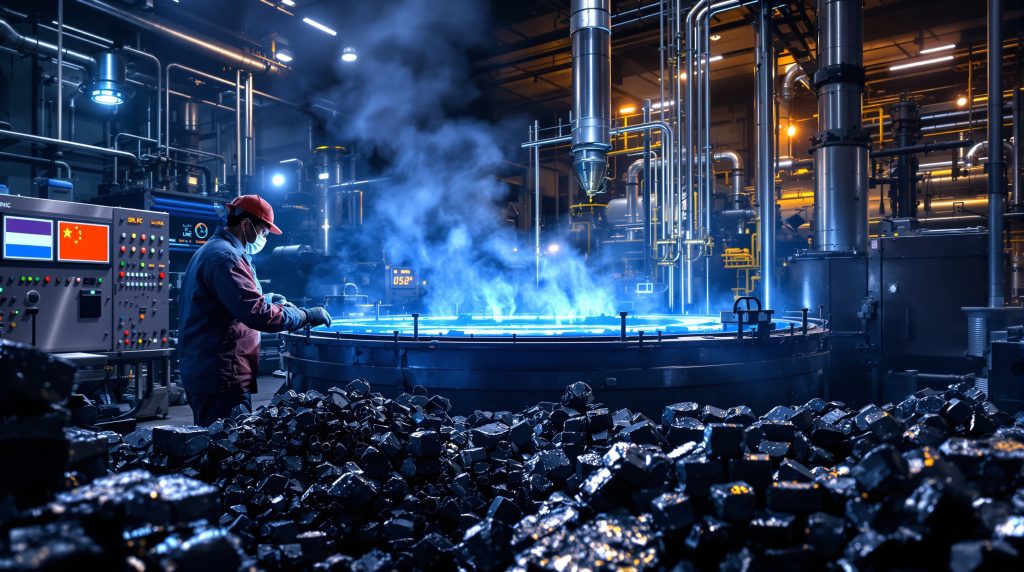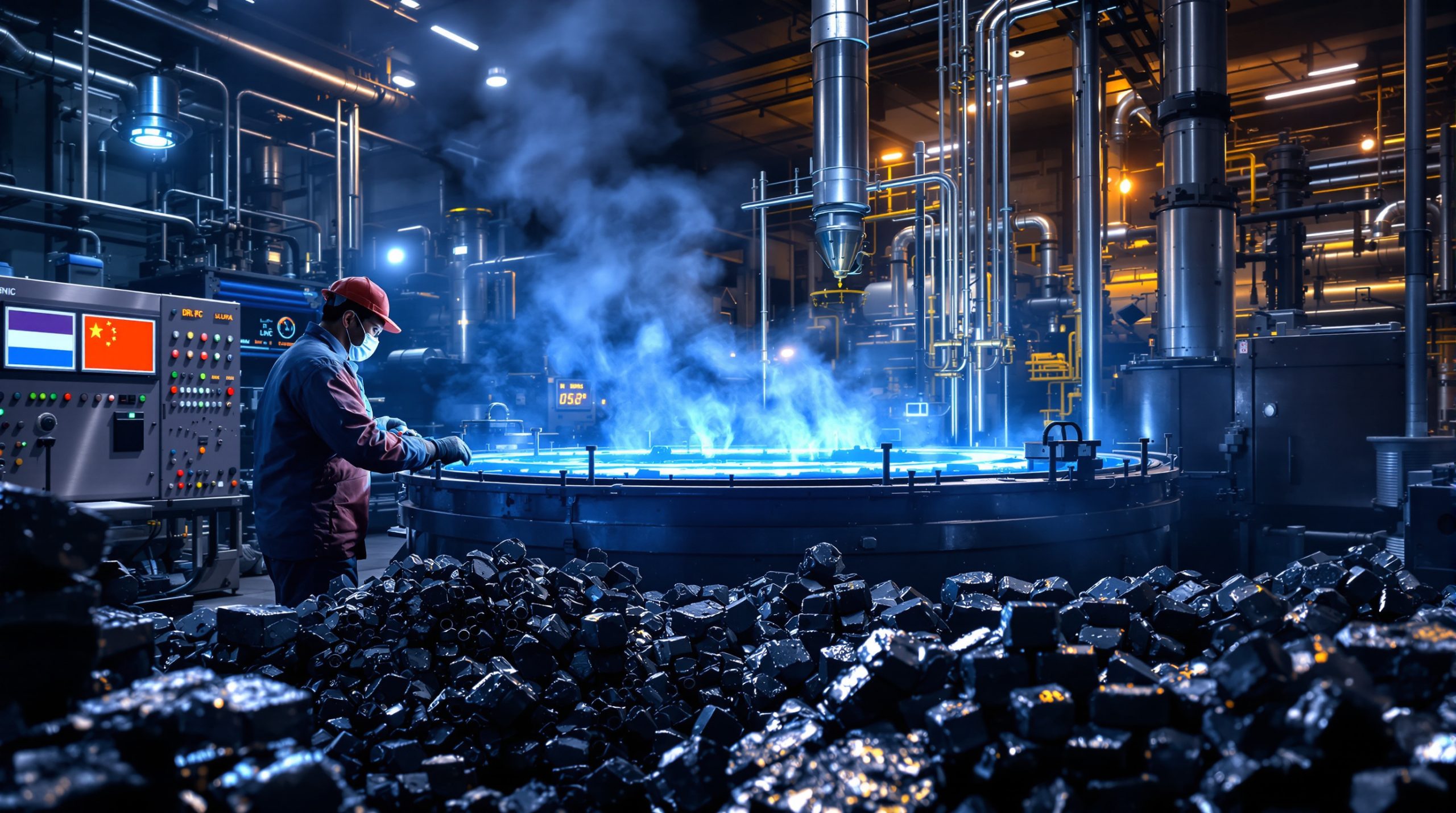The Evolution of Metal Dissolution in Chinese Cobalt Refining: Adapting to Supply Constraints
What Are the Key Challenges Facing Chinese Cobalt Refiners in 2025?
Chinese cobalt refiners metal dissolution has become a critical adaptation strategy as the industry navigates significant supply chain disruptions in 2025. With traditional hydroxide feedstock becoming increasingly scarce and expensive, refiners are implementing alternative processing methods to maintain production levels and meet market demand for cobalt chemicals.
The disruptions stem primarily from regulatory changes in the Democratic Republic of Congo (DRC), which has extended its cobalt export suspension and announced the implementation of a new quota system starting October 16, 2025. This policy shift creates immediate challenges, as shipments typically take around three months to reach China from the DRC, creating a substantial supply gap.
Market timing couldn't be worse for Chinese refiners, as these constraints coincide with the seasonal increase in demand for cobalt sulfate and tetroxide that typically occurs during September and October each year. These challenges have prompted significant cobalt blue expansion efforts in other regions to diversify supply.
Supply Chain Disruptions from Central Africa
The DRC's regulatory changes have fundamentally altered the cobalt supply landscape for Chinese refiners. These measures include:
- Extended suspension of cobalt exports from the region
- Introduction of a quota system beginning October 16, 2025
- Typical three-month shipping timeline creating immediate supply gaps
According to Fastmarkets data from October 2025, spot cobalt hydroxide has become "increasingly difficult to procure" with current price surges, forcing refiners to look at alternative processing options. The combination of extended export restrictions and the new quota system creates a perfect storm of supply constraints just as seasonal demand begins to peak.
"We've seen prices rise rapidly as the market digests the quota system and as new supply remains constrained," noted a market trader in early October 2025, highlighting the immediate market impact of these regulatory changes.
How Does Metal Dissolution Work as an Alternative Feedstock Process?
As Chinese cobalt refiners face unprecedented hydroxide shortages, many are turning to an alternative production method: metal dissolution. This process represents a significant shift in manufacturing methodology, requiring different equipment, expertise, and production timelines.
Technical Process of Cobalt Metal Dissolution
The metal dissolution process involves several key technical aspects:
- Chemical Conversion: Cobalt metal is dissolved using specialized acid solutions to create precursor materials suitable for sulfate and tetroxide production
- Extended Processing Cycle: The dissolution process typically requires approximately two weeks to complete, compared to faster processing times with hydroxide
- Material Format Challenges: Different physical forms of cobalt metal present varying dissolution challenges
- Equipment Requirements: Specialized dissolution lines are needed, often requiring significant production line adjustments
One industry source explained to Fastmarkets in October 2025: "Dissolving cobalt metal into sulfate has not previously been a common practice. Few smelters have dedicated production lines in place for this process."
Operational Challenges in Switching Feedstock Sources
The transition to metal dissolution presents several significant operational hurdles for Chinese refiners:
- Limited Production Capacity: Few refiners have dedicated dissolution lines already in place
- Material Format Constraints: Cobalt cathode (more readily available in the market) is harder to dissolve than briquette form
- Processing Timeline: Metal dissolution takes approximately two weeks, significantly longer than hydroxide processing
- Efficiency Considerations: One major producer noted facilities designed for briquette processing are less efficient when handling cobalt cathode
These technical challenges require substantial adaptation by Chinese refiners. As one major producer explained to Fastmarkets, the company has already adjusted its production line to accommodate metal dissolution, while other refiners indicated similar preparations were underway.
"We are preparing to melt cobalt metal. It has become an unavoidable option given the long shipping cycle for new hydroxide and the high costs of current feedstock," a cobalt smelter source told Fastmarkets in early October.
Why Are Chinese Refiners Pivoting to Metal Dissolution Now?
Despite the operational challenges, economic factors are driving Chinese refiners to implement metal dissolution processes in response to the current market dynamics. This shift is part of a broader mining industry evolution focused on adaptability and resource efficiency.
Economic Factors Driving the Transition
Several key economic considerations are pushing refiners toward metal dissolution:
- Favorable Price Differential: Current price dynamics have created a profitable spread between cobalt metal and sulfate
- Inventory Availability: Cobalt metal currently has "relatively higher inventories and more competitive prices compared with hydroxide"
- Production Continuity: Refiners must maintain output to fulfill existing customer orders despite feedstock challenges
- Long-term Contract Obligations: Many refiners have committed to supply agreements that require continued production regardless of input challenges
According to Fastmarkets reporting in October 2025, cobalt metal purchased within the range of 260,000-290,000 yuan per tonne could be profitably dissolved into sulfate at current price levels. This economic incentive has led some refiners to proactively stock metal in advance "to capture the spread," according to industry sources.
"The cost differential was attractive enough to justify the switch, and the dissolution of cobalt metal would better accommodate long-term orders for cobalt sulfate because hydroxide inventories are running low," one producer explained to Fastmarkets.
Comparative Economics of Feedstock Options
The economic comparison between different feedstock options reveals why metal dissolution has suddenly become viable:
| Feedstock Type | Current Availability | Processing Time | Cost Factors | Suitability for Sulfate Production |
|---|---|---|---|---|
| Cobalt Hydroxide | Severely limited | Shorter cycle | Price surging due to DRC restrictions | Traditional preferred input |
| Cobalt Metal | Relatively higher inventory | ~2 weeks | Economically viable at 260,000-290,000 yuan/tonne | Viable alternative with adaptation |
This economic calculation is driving immediate action among Chinese refiners, with several companies already reporting they have purchased metal in preparation for the transition and adjusted production lines accordingly.
What Market Signals Indicate This Shift in Processing Methods?
Clear market signals confirm this strategic pivot by Chinese cobalt refiners, with price movements across the cobalt value chain reflecting the anticipated processing shift.
Price Movements Reflecting Supply Constraints
Recent price movements clearly signal the market's response to these supply challenges:
- Cobalt Sulfate: Prices increased to 65,000-70,000 yuan ($9,112-9,812) per tonne by early October 2025, representing a 7.14% increase from 62,000-64,000 yuan per tonne the previous day, according to Fastmarkets data
- Cobalt Metal: Prices rallied to 316,000-325,000 yuan per tonne by late September 2025, up 8.09% from 290,000-303,000 yuan per tonne earlier in the month
- Price Trajectory: Cobalt sulfate has risen significantly from 58,000-60,000 yuan per tonne in mid-September 2025
These sharp price increases demonstrate how quickly the market is responding to both the DRC export restrictions and the anticipated shift in processing methods by Chinese refiners.
"I expect in the short term that prices will not come down easily, given the bullish sentiment across the market," a trader told Fastmarkets in early October, highlighting the persistent upward pressure on prices.
Industry Preparations and Adaptations
Multiple industry sources confirm widespread preparations for this processing shift:
- Several Chinese smelters have already purchased cobalt metal in anticipation of hydroxide shortages
- At least one major producer has completed production line adjustments to accommodate metal dissolution
- Other refiners are in various stages of preparation for similar processing changes
- Some refiners have proactively built metal inventory to capitalize on the economic opportunity
"I see smelters preparing to dissolve metal as a turning point. It signals that hydroxide inventories are nearly depleted and that more refiners will have no choice but to turn to metal," a trader explained to Fastmarkets, highlighting how this shift represents a significant inflection point for the industry.
How Will This Processing Shift Impact Global Cobalt Markets?
The transition to metal dissolution by Chinese cobalt refiners will have ripple effects throughout global cobalt markets, creating both short-term challenges and potential long-term structural changes. These changes are also influencing EV supply chain dynamics as manufacturers seek stable material sources.
Short-Term Market Implications
The immediate market effects of this processing shift include:
- Accelerated Price Pressure: Continued upward pressure on cobalt metal prices as refiners secure feedstock
- Supply Tightness: Further market tightening as metal inventories are drawn down for dissolution
- Product Availability: Potential constraints in cobalt chemical availability during the transition period
- Processing Bottlenecks: Limited dissolution capacity creating production constraints
According to market sources, this shift "will only tighten the market further and keep prices on an upward trajectory" as refiners compete for available metal supplies. The conversion of metal to sulfate creates an additional demand layer for metal that wasn't previously factored into market balances.
Long-Term Industry Adaptations
Looking beyond the immediate disruption, several longer-term adaptations may emerge:
- Processing Flexibility: Refiners likely to maintain dual-feedstock capabilities for future supply disruptions
- Infrastructure Investment: Potential increased investment in dedicated metal dissolution facilities
- Supply Chain Diversification: Greater emphasis on securing diverse cobalt sources beyond the DRC
- Contract Structure Changes: Revised pricing models that account for feedstock flexibility
This adaptation demonstrates the resilience of Chinese refiners and their ability to maintain production continuity despite significant supply chain challenges. The experience gained through this transition may permanently alter industry practices and supply chain structures.
What Technical Innovations Are Supporting Metal Dissolution?
To overcome the challenges associated with metal dissolution, Chinese refiners are implementing various technical innovations and process improvements. These innovations complement emerging battery recycling innovations that are helping to create a more circular supply chain.
Hydrometallurgical Processing Advancements
Chinese refiners are leveraging advanced hydrometallurgical techniques to optimize metal dissolution:
- Optimized Acid Solutions: Development of specialized acid formulations that maximize dissolution efficiency while minimizing reagent consumption
- Temperature Control Systems: Implementation of precise temperature management to accelerate dissolution rates
- Impurity Management Protocols: Advanced techniques for controlling and removing impurities during the dissolution process
- Catalyst Integration: Addition of catalytic agents that enhance dissolution kinetics
These technical advancements help address the extended processing timeline that has traditionally made metal dissolution less attractive than hydroxide processing.
Process Efficiency Improvements
To offset the challenges of metal dissolution, refiners are implementing various efficiency measures:
- Streamlined Dissolution Cycles: Process optimization to reduce the typical two-week processing timeline
- Reagent Recovery Systems: Implementation of closed-loop systems that recover and reuse acid solutions
- Enhanced Monitoring Capabilities: Real-time process monitoring to optimize dissolution parameters
- Material Pre-Treatment: Surface preparation techniques that enhance dissolution rates, particularly for cathode material
These innovations represent the industry's rapid response to supply chain challenges, demonstrating the technical adaptability of Chinese refiners when faced with feedstock constraints.
What Does This Mean for Downstream Battery Supply Chains?
The shift in cobalt processing methodologies has significant implications for downstream battery material supply chains, particularly for electric vehicle manufacturers and energy storage applications. These developments align with broader critical minerals strategy initiatives focused on securing essential materials for the energy transition.
Impact on Battery Material Production
The shift in feedstock processing has several implications throughout the battery supply chain:
- Chemical Specification Consistency: Potential variations in cobalt chemical specifications during the transition period
- Production Volumes: Possible temporary reductions in cobalt chemical availability during process adaptation
- Cost Structure Changes: Altered production economics potentially affecting downstream pricing
- Quality Assurance Challenges: Need for enhanced quality verification during the transition period
These factors may create additional challenges for battery material producers who rely on consistent cobalt chemical inputs for their manufacturing processes.
Electric Vehicle Manufacturing Considerations
As a critical component in lithium-ion batteries, cobalt supply disruptions have potential implications for electric vehicle production:
- Supply Chain Risk Assessment: Manufacturers with secured supply chains gain competitive advantages
- Chemistry Adaptation: Potential acceleration of efforts to reduce cobalt content in battery formulations
- Inventory Management: Strategic stockpiling of critical materials to buffer against supply disruptions
- Vertical Integration: Increased interest in securing upstream supply through direct investment or partnerships
Forward-thinking EV manufacturers have been diversifying battery chemistries to reduce dependence on cobalt, but the current supply constraints may accelerate these efforts and create additional incentives for developing alternative technologies.
FAQ: Chinese Cobalt Refining and Metal Dissolution
How long does the cobalt metal dissolution process take?
The process of dissolving cobalt metal into usable sulfate typically takes approximately two weeks, which is significantly longer than processing using cobalt hydroxide. This extended timeline creates additional planning challenges for refiners managing production schedules and fulfilling customer orders.
What forms of cobalt metal are most suitable for dissolution?
Cobalt briquette is generally considered more suitable for dissolution processes, as it dissolves more readily. However, cobalt cathode is more commonly available in the market, despite being more challenging to process through dissolution methods. Facilities designed for briquette processing typically experience reduced efficiency when handling cathode material.
How do DRC export quotas affect Chinese refiners specifically?
The DRC export quotas create particular challenges for Chinese refiners, who have historically relied heavily on DRC-sourced cobalt hydroxide. With approximately three months of shipping time between the DRC and China, the quotas create an immediate supply gap that coincides with seasonal demand increases. This timing mismatch forces refiners to seek alternative feedstock sources to maintain production continuity.
What price points make metal dissolution economically viable?
According to market sources reported by Fastmarkets in October 2025, cobalt metal purchased within the range of 260,000-290,000 yuan per tonne can be profitably dissolved into sulfate when sulfate prices exceed 65,000 yuan per tonne. This economic equation may shift as market conditions evolve and as refiners gain experience with the dissolution process.
Are these processing changes likely to be temporary or permanent?
While initially implemented as a response to immediate supply constraints, many industry observers believe refiners will maintain dual-processing capabilities going forward. This flexibility will allow them to optimize feedstock selection based on market conditions and supply availability, creating greater resilience against future supply disruptions, as detailed in the Cobalt Institute's market report.
Conclusion: Adaptation and Innovation in Cobalt Processing
The shift toward metal dissolution represents a significant adaptation by Chinese cobalt refiners facing unprecedented supply challenges. This transition demonstrates the industry's resilience and flexibility in maintaining production continuity despite regulatory and supply chain disruptions.
As refiners gain experience with metal dissolution processes, efficiency improvements and technical innovations are likely to emerge, potentially creating new standard practices within the industry. The current supply constraints may ultimately lead to a more diversified and resilient cobalt processing sector with greater feedstock flexibility.
Market participants should closely monitor price movements in both cobalt metal and cobalt chemicals as indicators of the effectiveness and broader impact of these processing adaptations. The coming months will reveal whether these changes represent a temporary adjustment or a more fundamental shift in cobalt refining methodologies.
Want to Spot the Next Major Mineral Discovery?
Stay ahead of the market with Discovery Alert's proprietary Discovery IQ model, which instantly notifies investors of significant ASX mineral discoveries and transforms complex data into actionable investment opportunities. Explore historic returns of major mineral discoveries at https://discoveryalert.com.au/discoveries/ and position yourself for market-leading success.




